CPS Unit Number 051-01
Camp: 51
Unit ID: 1
Operating agency: BSC
Opened: 9 1942
Closed: 10 1945
Workers
Total number of workers who worked in this camp: 36
-
 CPS Camp No. 51, Ft. Steilacoom, Washington"Back ward" mealtimeDigital image from the Center on Conscience and War Records (DG 025), Swarthmore College Peace Collection, Swarthmore, PennsylvaniaMay, 1943
CPS Camp No. 51, Ft. Steilacoom, Washington"Back ward" mealtimeDigital image from the Center on Conscience and War Records (DG 025), Swarthmore College Peace Collection, Swarthmore, PennsylvaniaMay, 1943 -
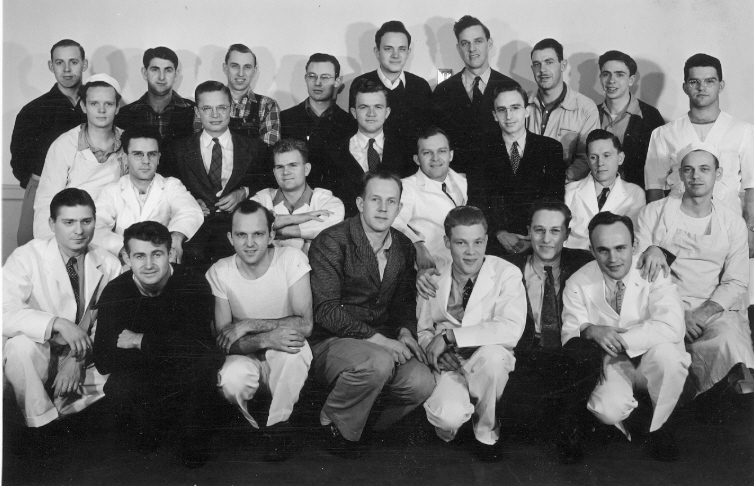 CPS Camp No. 51, Fort Steilacoom WashingtonUnit group, December 21, 1943 - Left to right, Front Row:Albert Benglen, attendant; Bill Phillips, attendant; Ray Vanderburg, clinical laboratory technician; Bill Cable, truck driver; Henry Carlsen, attendant; Victor Langford, business office worker; Lloyd Hall, attendant - Second Row: Bill Henderson, attendant; Leo Baldwin, attendant; Charles Mahin, attendant; Kenneth Kimmel, attendant; Jim Winker, cook - Third Row: Windsor Utley, cook; David Salstrom, poultryman; Robert Lam, accountant; Allen Hastings, social service worker; Henry Blocher, photographer - Back Row: Loyd Schaad, groundsman; Sam Liskey, poultry man; Elmer Lewis, truck driver; Bruce Dean, truck driver; Charles Ludwig, attendant; Harold Petry, dairyman; Marion Ross, dairyman; Kenneth Kester, poultry.Digital Image © 2011 Brethren Historical Library and Archives. All Rights Reserved.December 21, 1943
CPS Camp No. 51, Fort Steilacoom WashingtonUnit group, December 21, 1943 - Left to right, Front Row:Albert Benglen, attendant; Bill Phillips, attendant; Ray Vanderburg, clinical laboratory technician; Bill Cable, truck driver; Henry Carlsen, attendant; Victor Langford, business office worker; Lloyd Hall, attendant - Second Row: Bill Henderson, attendant; Leo Baldwin, attendant; Charles Mahin, attendant; Kenneth Kimmel, attendant; Jim Winker, cook - Third Row: Windsor Utley, cook; David Salstrom, poultryman; Robert Lam, accountant; Allen Hastings, social service worker; Henry Blocher, photographer - Back Row: Loyd Schaad, groundsman; Sam Liskey, poultry man; Elmer Lewis, truck driver; Bruce Dean, truck driver; Charles Ludwig, attendant; Harold Petry, dairyman; Marion Ross, dairyman; Kenneth Kester, poultry.Digital Image © 2011 Brethren Historical Library and Archives. All Rights Reserved.December 21, 1943 -
 CPS Camp No. 51, Fort Steilacoom WashingtonFront entrance to main building - Western State Hospital.Digital Image © 2011 Brethren Historical Library and Archives. All Rights Reserved.
CPS Camp No. 51, Fort Steilacoom WashingtonFront entrance to main building - Western State Hospital.Digital Image © 2011 Brethren Historical Library and Archives. All Rights Reserved. -
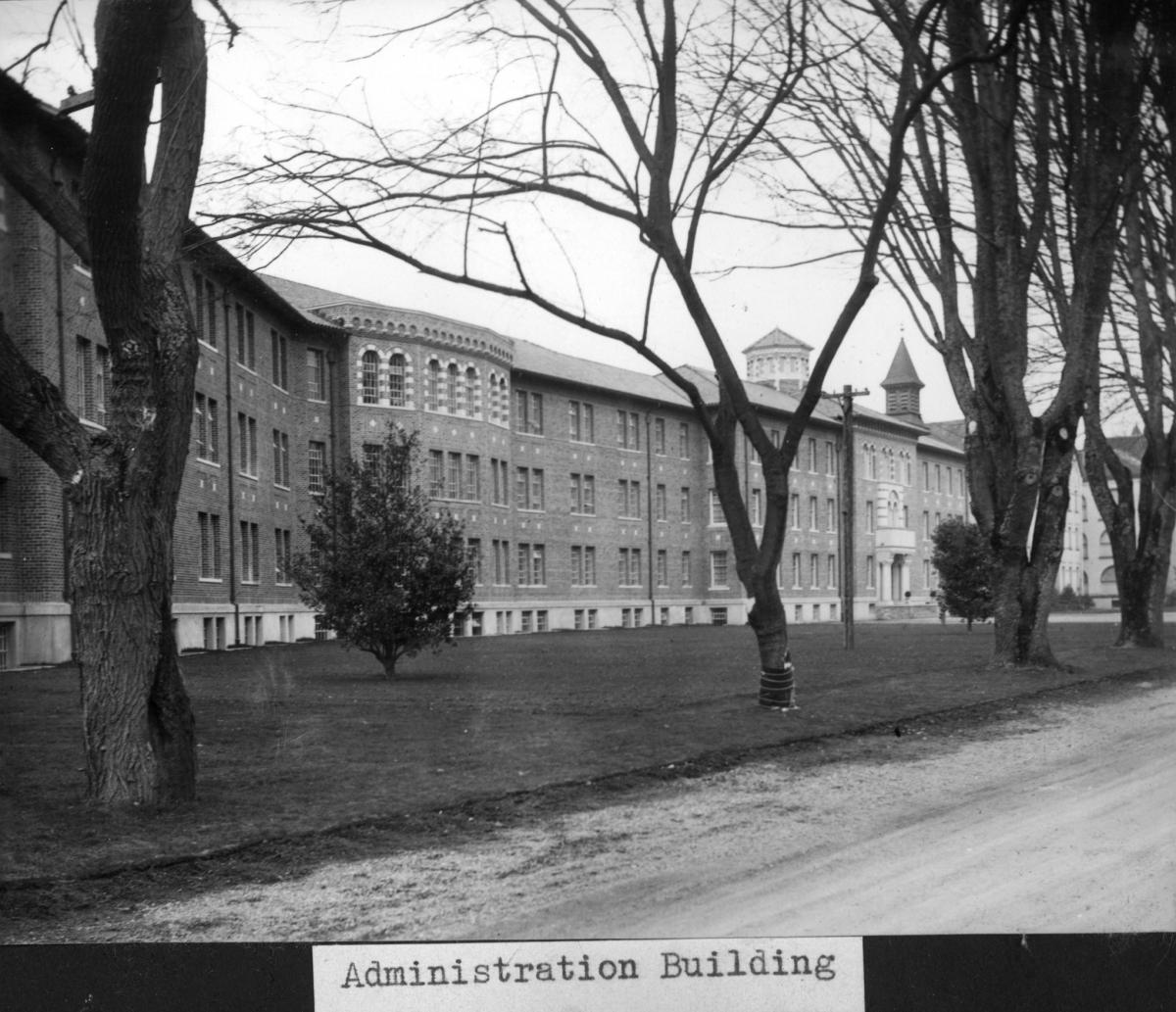 CPS Camp No. 51, Fort Steilacoom, WashingtonWestern State Hospital Administration Building, Ft. Steilacoom, Washington.Washington State Archives
CPS Camp No. 51, Fort Steilacoom, WashingtonWestern State Hospital Administration Building, Ft. Steilacoom, Washington.Washington State Archives -
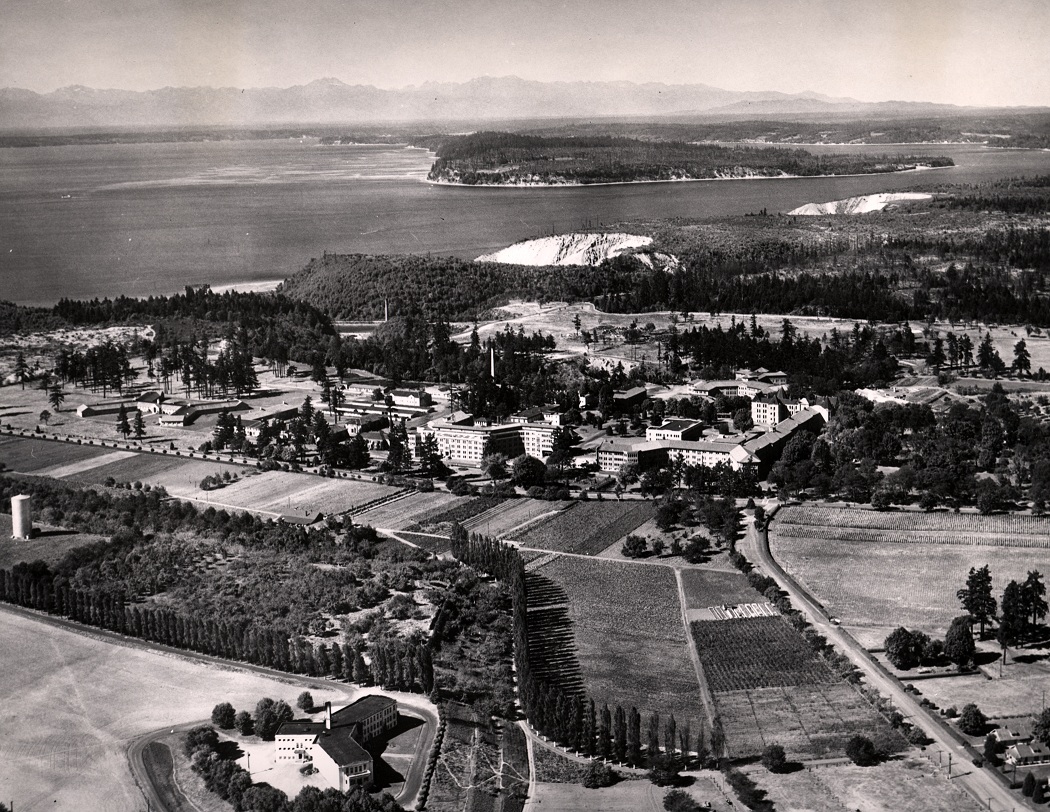 CPS Camp No. 51Aerial view of Western State Hospital, Ft. Steilacoom, Washington.Washington State Archives
CPS Camp No. 51Aerial view of Western State Hospital, Ft. Steilacoom, Washington.Washington State Archives -
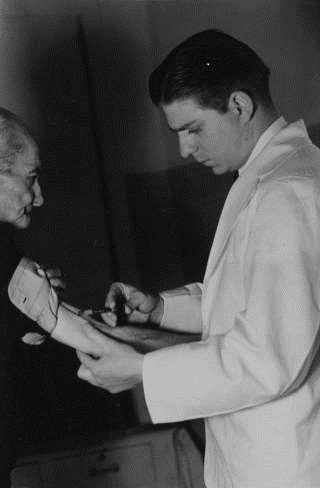 CPS Camp No. 51Al Benglen attending to a patient at Washington State Hospital, CPS Camp 51.Lewis and Clark Digital Collection, Special Collections, Henry and Mary Blocher Collection1943
CPS Camp No. 51Al Benglen attending to a patient at Washington State Hospital, CPS Camp 51.Lewis and Clark Digital Collection, Special Collections, Henry and Mary Blocher Collection1943 -
 CPS Camp No. 51Loyd Schaad working as a groundskeeper at Washington State Hospital, Camp 51.Lewis and Clark Digital Collection, Special Collections, Henry and Mary Blocher Collection1943
CPS Camp No. 51Loyd Schaad working as a groundskeeper at Washington State Hospital, Camp 51.Lewis and Clark Digital Collection, Special Collections, Henry and Mary Blocher Collection1943 -
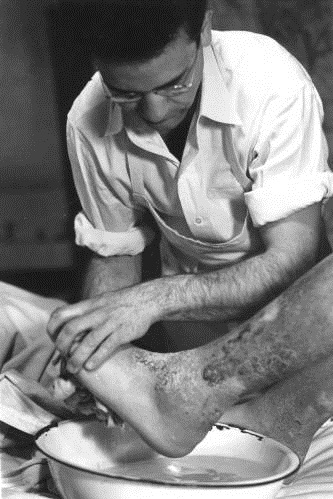 CPS Camp No. 51Bill Henderson working as an attendant in the senile ward at Washington State Hospital.Lewis and Clark Digital Collection, Special Collections, Henry and Mary Blocher Collection1943
CPS Camp No. 51Bill Henderson working as an attendant in the senile ward at Washington State Hospital.Lewis and Clark Digital Collection, Special Collections, Henry and Mary Blocher Collection1943 -
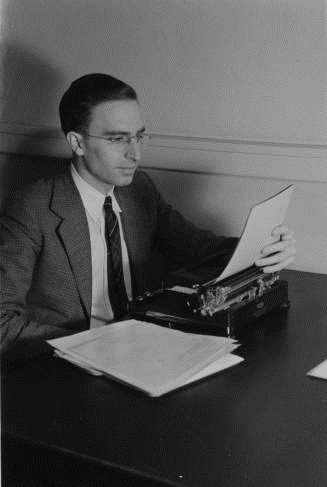 CPS Camp No. 51Al Hastings working as a social worker at Washington State Hospital, Camp 51.Lewis and Clark Digital Collection, Special Collections, Henry and Mary Blocher Collection1943
CPS Camp No. 51Al Hastings working as a social worker at Washington State Hospital, Camp 51.Lewis and Clark Digital Collection, Special Collections, Henry and Mary Blocher Collection1943 -
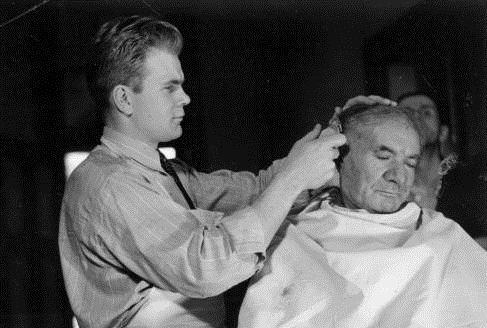 CPS Camp No. 51Leo Baldwin cutting the hair of a hospital patient at Camp 51.Lewis and Clark Digital Collection, Special Collections, Henry and Mary Blocher Collection1943
CPS Camp No. 51Leo Baldwin cutting the hair of a hospital patient at Camp 51.Lewis and Clark Digital Collection, Special Collections, Henry and Mary Blocher Collection1943 -
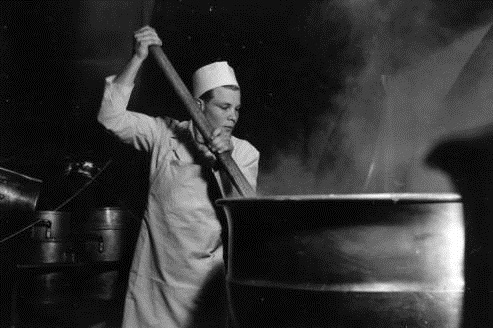 CPS Camp No. 51Henry Carlsen working in the kitchen at Washington State Hospital, Camp 51.Lewis and Clark Digital Collection, Special Collections, Henry and Mary Blocher Collection1943
CPS Camp No. 51Henry Carlsen working in the kitchen at Washington State Hospital, Camp 51.Lewis and Clark Digital Collection, Special Collections, Henry and Mary Blocher Collection1943 -
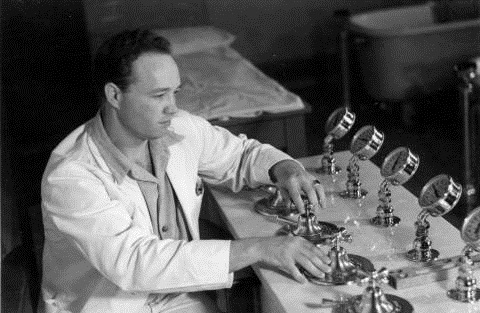 CPS Camp No. 51Walter Baumann conducting hydrotherapy on hospital patients at Camp 51.Lewis and Clark Digital Collection, Special Collections, Henry and Mary Blocher Collection1943
CPS Camp No. 51Walter Baumann conducting hydrotherapy on hospital patients at Camp 51.Lewis and Clark Digital Collection, Special Collections, Henry and Mary Blocher Collection1943 -
 CPS Camp No. 51Marion Ross working at Camp 51.Lewis and Clark Digital Collection, Special Collections, Henry and Mary Blocher Collection of Civilian Public Service Photographs, Steilacoom E81943
CPS Camp No. 51Marion Ross working at Camp 51.Lewis and Clark Digital Collection, Special Collections, Henry and Mary Blocher Collection of Civilian Public Service Photographs, Steilacoom E81943
-
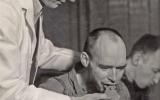 May, 1943
May, 1943 -
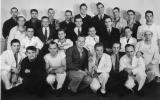 December 21, 1943
December 21, 1943 -
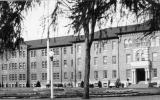
-
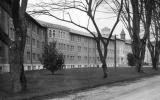
-

-
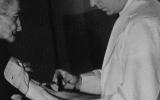 1943
1943 -
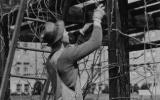 1943
1943 -
 1943
1943 -
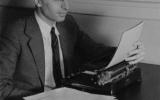 1943
1943 -
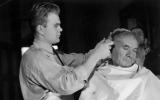 1943
1943 -
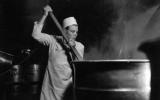 1943
1943 -
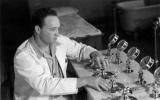 1943
1943 -
 1943
1943
CPS Unit No. 51, a Mental Hospital unit located at Western State Hospital in Fort Steilacoom, Washington and operated by the Brethren Service Committee, opened in September 1942 and closed in October 1945. The majority of the men served as ward attendants.
Western State Hospital was located in Fort Steilacoom, Washington. A group of men from CPS Camp No. 21 at Cascade Locks, Oregon had been reviewing several potential sites for a detached service mental health unit in Oregon and Washington sites prior to selecting Western State Hospital (see Kovac p. 58).
Directors: Charles Davis, Lloyd Hall
Fifteen men from CPS Camp No. 21 at Cascade Locks, Oregon transferred to Western State Hospital to open the unit, including both Lloyd Hall and Charles Davis. Others included Bill Phillips who had served as Camp President, Al Hastings who began the camp chorus and Windsor Utley, a flautist. Four others served in capacities other than ward attendants: Bill Cable as a truck driver; Henry Carlsen as kitchen worker; Loyd Schaad with an M.S. in horticulture managed the hospital grounds; and Henry Blocher became the hospital photographer.
The majority of the men served as ward attendants, although some also served in clerical, agricultural, maintenance and construction, motor vehicle operation, technical and professional as well as food preparation roles. Of the 17,490 person hours accomplished during the life of the unit at Western State Hospital, ward attendants provided 5,532 hours while those serving in clerical roles gave 2,266 hours, and those in agriculture contributed 3,744 hours of service. (Selective Service form DSS 52 as published in Eisan p. 212)
The work of ward attendant involved complete housekeeping (sweeping, mopping, waxing and polishing floors, bed making and caring for patients’ clothes). Attendants supervised patients and assisted them in eating, bathing, dressing and undressing. In addition, an attendant might serve as an aide in giving various treatments including dressings, injections, electric shock and hydrotherapy. Ward attendants also accompanied patients on walks, in recreational and social activities. Men worked in male wards.
Washington Governor Arthur B. Langlie was fully supportive of using religious objectors in the state’s public agencies.
The men published Washington Newsletter in December 1942. Beginning in October 1943, the first issue of Factor appeared. The name was changed to Viewpoint and the paper was published through April 1945.
A group of camp men organized The Pacifist Information Center to achieve two goals—1) the development of unity so that the"full impact of the pacifist movement can be brought to bear on the public in those areas and at those times when public opinion is most receptive"; 2) "acquainting the public with pacifist principles, methods, and accomplishments by. . .effective means of information and education." Victor Langford so described the goals in Viewpoint II:1 (April 12, 1945). (in Eisan p. 231) The organizers hoped that other pacifists beyond the unit would cooperate with and support their work.
The men developed a library with an excellent research collection of pacifist books, pamphlets, periodicals. They also helped locate out of print pacifist books for prospective buyers. As a second emphasis, the unit publication Viewpoint focused on pacifist issues and was regarded as one of the best Brethren CPS publications.
For information on Brethren mental health and training school units see Leslie Eisan, Pathways of Peace: A History of the Civilian Public Service Program Administered by the Brethren Service Committee. Elgin, IL: Brethren Publishing House, 1948, Chapter 6 pp. 205-238.
See also Jeffrey Kovac, Refusing War, Affirming Peace: A History of Civilian Public Service Camp No. 21 at Cascade Locks. Corvalis, OR: Oregon State University Press, 2009.
See also Alex Sareyan, The Turning Point: How Persons of Conscience Brought About Major Change in the Care of America’s Mentally Ill. Scottdale, PA: Herald Press, 1994.
For an in depth history of conscientious objection in the United States, see Mulford Q. Sibley and Philip E. Jacob, Conscription of Conscience: The American State and the Conscientious Objector, 1940-1947. Ithaca, NY: Cornell University Press, 1952, including a description of other CPS camp institutes on peace studies, pp. 191-92.
Swarthmore College Peace Collection, Camp publications database.
For more in depth treatment of mental hospital units, see Steven J. Taylor, Acts of Conscience: World War II, Mental Institutions, and Religious Objectors. Syracuse, NY: Syracuse University Press, 2009.